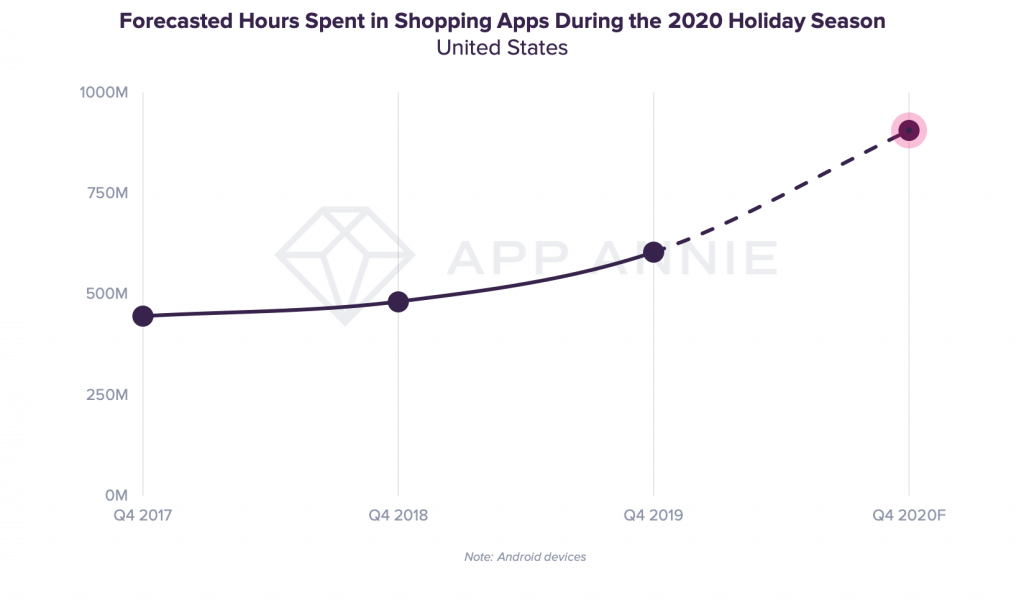Global economies are still reeling from the COVID-19 pandemic, and a major consequence is that this year’s holiday season is poised to be very different to those in the past.
App Annie is predicting the biggest Q4 holiday shopping season on m-commerce yet, with nearly 1 billion hours to be spent on Android devices in the US, up 50% YoY
At the crux of these changes are the overwhelming shift to mobile — in retail, this is registered as the boom in couch commerce, or shopping from the (socially distant) comfort of home on your smartphone.
The report puts industry expertise and mobile data to work to provide companies with three forecasts on this year’s holiday shopping season, so they can prepare to succeed in the mobile channel.
Growth in Mobile Shopping Will Be Spread Throughout Q4 2020 and Less Concentrated in the Weeks of Black Friday and Cyber Monday
The report expects a longer, drawn-out shopping season this year, due to two main factors: Amazon’s Prime Day being delayed July to October 2020, as well as a contraction in the US economy. Heading into Q3 2020, unemployment rates are still higher in many markets than the highest during the Great Financial Crisis and in some more than 2x pre-COVID rates.
This manifests in lower disposable incomes and greater price sensitivity for many consumers. In this climate, expect consumers to seek deals and promotions for longer throughout the leadup to the holidays.
While retail sales dipped in Q2 to -19.9% YoY in April 2020, they are expected to outpace the economy overall and be back up to 2.2% YoY growth in Q3 2020. There are normally peaks in time spent in Shopping apps surrounding Prime Day, Black Friday and Cyber Monday each year in July and November, respectively.
With Prime Day taking place much closer to Black Friday and Cyber Monday, and Amazon consistently ranking #1 by monthly active users (MAU) among Shopping apps in the US and commanding a strong cross-app usage with other top apps, it is likely Prime Day steals a bit of thunder from the November shopping days.
Retailers should consider timing promotions alongside Prime Day in addition to Black Friday and Cyber Monday, leveraging exclusive and unique deals, promotions and giveaways across each day to keep customers engaged throughout Q4.
1 Billion Hours To Be Spent in Shopping Apps in US in Q4
With the elongated shopping season and increase in e-commerce, the report expects Q4 2020 to be the biggest mobile shopping season to date — surpassing 1 billion hours on Android devices alone, a 50% increase from Q4 2019.

Driven by the need for essentials while maintaining home lockdowns, e-commerce boomed in H1 2020, achieving growth that normally would have taken between 4 and 6 years — and mobile was central to this growth. In the US and UK, total weekly sessions — a proxy for foot traffic — in Shopping apps during peak weeks in the busy holiday season of Q4 2019 by as much as 25% and 15% respectively.

E-commerce on mobile has boomed under COVID lockdowns and social distancing policies. And this behaviour is here to stay, as this is building on existing consumer behaviour. M-commerce steadily growing in influence every year in Western markets, which has lagged behind Eastern markets.
A few categories we expect to see growth this holiday season include:
- Payments: PayPal — who also owns Venmo — reported its best quarter ever, with total payment volume increasing 29% year over year. Part of this success is due to prioritizing mobile features that meet consumers’ needs during COVID-19, including QR codes and contactless payments.
- Grocery: Driven by demand for mobile ordering of groceries, weekly sessions in Shopping apps remained elevated in Q2 2020, notably in Brazil and the US. In the leadup to Thanksgiving Day in the US, mobile grocery app usage will remain high as shoppers leverage apps for evaluating inventory, self-checkout, delivery and Buy Online Pickup In Store (BOPIS) fulfillment options to abide by COVID policies and health guidelines.
- Delivery Services: We expect apps such as UberEATS, DoorDash, and Grubhub will become valuable solutions for those limiting contact and dining-in due to cold weather. In Q2 2020, demand for food delivery and QSR apps lead to 45% growth in average weekly sessions of Food and Drink apps from Q4 2019.
It is primetime for User Acquisition (UA). Every interaction with your brand is an opportunity to delight, so prioritizing mobile-first features to cultivate customer satisfaction and loyalty on mobile can go a long way in the weeks after Prime Day, Black Friday and Cyber Monday, when engagement is high.
Preparing for Q4 2020 Holiday Season
To capitalise on this busy time, companies should prioritise mobile advertising and take stock of their App Store Optimization (ASO) strategy to maximise organic traffic and prioritise mobile features to delight users. Retailers should take note of how they stack up to the competition and what companies grew in last year’s holiday season to better prepare an offensive mobile strategy this year.
Mobile shopping correlates strongly with consumer spend in retail — both through e-commerce and physical stores. With COVID-19 lockdowns and social distancing policies accelerating mobile shopping, mobile is mission-critical to reaching consumers this holiday season.
The post Consumers to spend 1 billion hours on m-commerce over Holiday season appeared first on Payments Cards & Mobile.



